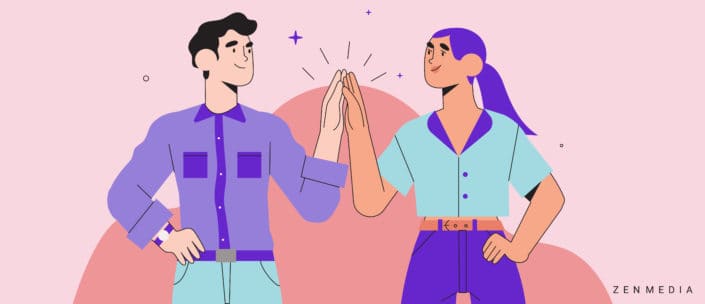What do Abbott and Costello, Fred Astaire and Ginger Rogers, Mary-Kate and Ashley Olsen, and Barbie and Ken all have in common? They are all ubiquitous brands. Each of these iconic duos is a well-known, impactful brand that people recognize worldwide. You wouldn’t have one without the other, and that’s what makes them great. Fred Astaire and Ginger Rogers movies were blockbuster hits. Mary-Kate and Ashley Olsen took the 2000s fashion scene by storm.
Sometimes two is just better than one.
In business, brand partnerships can boost sales, encourage customer engagement, and reinvigorate your business model altogether. When two equally dynamic companies partner to create a shared strategy, it extends the brand’s reach and puts each partner in the sightline of their counterpart’s audience.
It’s a win-win.
Interested in trying a brand partnership to boost engagement and win new customers? Let us talk you through the basics so you can figure out how to engineer the best brand partnership for you.
What is a brand partnership?
Before launching into creating an effective brand partnership, you need to know the basics. A brand partnership is when two individual companies create a campaign together that has a shared goal. More often than not, brand partnerships help companies reach new audiences they were previously unable to reach. Because of this, brand partnerships often happen across sectors, industries, and countries.
Both brands bring something into the partnership, and the shared work should be mutually beneficial. Digital marketing around a brand partnership will include both brand’s logos, messaging that fits each brand’s voice, and a clear indicator that it’s a partnership.
What makes an effective brand partnership?
A brand partnership is effective when it wins customer attention and interest. Every brand partnership should create buzz, encourage customers to ask questions, and have a degree of intrigue. An effective brand partnership is compelling, whether your partnership is a months-long campaign or specific to a single event.
Some of our favorite brand partnerships are:
- Zendaya and Squarespace: We loved this partnership because Squarespace generated a ton of buzz around the event long before their commercial ran. This is a great example of a company taking a moment and giving it momentum. The reach of the brand partnership was extended because they hyped it up prior to the event.
- Doordash and United Way: During the pandemic, Doordash and United Way partnered to deliver food to people in need. This partnership is an excellent example of two equally powerful but incredibly different brands coming together to achieve a purpose. This one gets extra kudos for the positive impact the brands created together.
- Apple and Mastercard: These leading brands partnered to create an innovative new platform. This is a good example of two industry leaders coming together to make an even better product for consumers.
Related reading: The Zendaya Method: How to Take Your Strategy to the Tipping Point
How can I choose the right brand partner?
Choosing the right partner is the most crucial part of this process, and a couple of factors contribute to success. First and foremost, your partnership must be strategic. Identify the audience that you want to reach and then, from there, identify potential brand partners. Let’s say you’re a B2B in the software technology space. If you want to extend your brand’s reach within a specific sector, partner with a leader in that particular industry. Determine the intersection of your brand and theirs, and craft your campaign around that convergence.
An important note: Make sure that your brand partner is a good culture fit.
Just as you choose to hire new team members based on their fit with your company culture, take the same approach as you consider a brand partnership. Does your potential partner share similar values? Are they willing to work together and collaborate? Can you communicate with your partner effectively? Do you trust their expertise in the field, and do they trust yours?
These are all essential questions to ask in the beginning stages of your partnership.
How can B2B companies develop creative brand partnerships?
In 2022, it’s not enough to pick a good brand partner and launch a new digital campaign. You must be creative. Squarespace’s partnership with Zendaya was so successful because it was timely and engaged the customer for an extended period. It was unique, played off her celebrity status, and was anchored to a cultural story (“She sells seashells by the seashore.”) that people would recognize.
Many people have the sad expectation that B2B marketing is boring, straightforward, and anything but creative. Perhaps in the old days—prior to social media and digital strategies—B2B marketing was limited to in-person sales strategies, but now, B2B companies can leverage digital experiences to create more engaging campaigns.
A B2B brand partnership will have two objectives. First, it exists to extend the reach of both brands by targeting two audiences simultaneously. Second, a B2B brand partnership exists to connect both brands with qualified leads.
With this in mind, a brand marketing campaign must be able to answer the questions qualified leads will have and simultaneously engage a broad audience. So how can brands do this? It’s a combination of trend savviness, a consistent brand voice, and an understanding of the strategies that engage audiences.
Can brand partnerships increase sales?
Short answer: yes, brand partnerships can increase sales.
Long answer: brand partnerships are a critical part of the modern sales cycle, especially in the B2B space. In 2021, Forrester found that it takes 27 buying interactions before B2B customers make a purchase. Brand partnerships add value in this longer sales cycle by increasing the number of times, places, or ways the customer interacts with your brand. Chances are high that if you’ve chosen a brand partner whose mission aligns with your own, some of your customers may also be some of their customers. As you partner with this brand, your visibility increases, and you are more likely to reach new customers. Brand partnerships can also increase sales by boosting trust. Your customers’ confidence in your brand will now extend to your partner’s brand and vice versa.
Are brand partnerships a good investment during a recession?
Cultivating a brand partnership is a smart marketing tactic even in the face of a recession because it doubles down on the most important goals of marketing: staying in front of customers and extending the brand’s reach. We’ve said this before, but it’s worth repeating: don’t cut your marketing in the face of a recession. A brand partnership is a foolproof way to extend your brand’s reach and keep your company in front of customers.
While brand partnerships have been around for many years, we’re about to see an increase as companies become more creative and collaborative when generating brand awareness and consumer trust. The future of brand partnerships will see more companies crossing industry lines to connect with like-minded brands whose consumers overlap with their own. We’ll see more strategic partnerships that are built on shared value systems.
Related reading: 5 Reasons Why You Should Invest in Digital Marketing and PR During a Recession
The brand partnerships of the future will be about creating meaningful consumer experiences and buyers’ journeys that offer more than simply a product to purchase. Brand partnerships of the future will connect consumers to missions, values, and creative ideas that generate interest and solidify brand trust.





